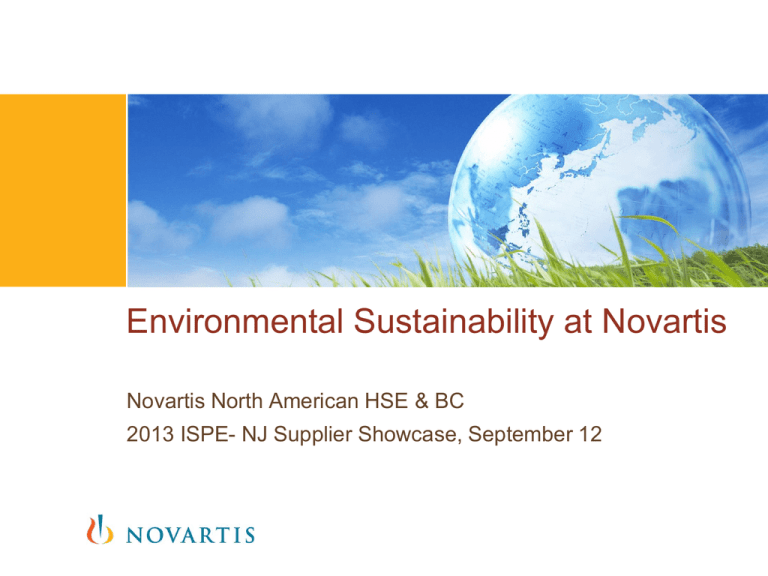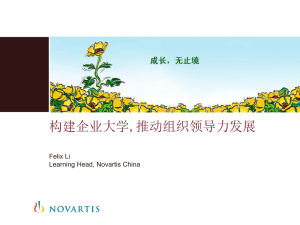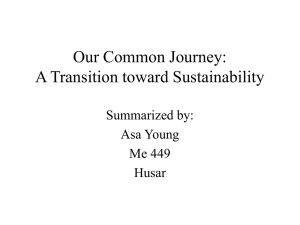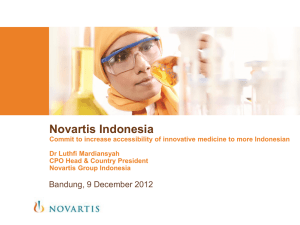Presentation
advertisement

Environmental Sustainability at Novartis Novartis North American HSE & BC 2013 ISPE- NJ Supplier Showcase, September 12 We work responsibly and ethically Our patients and customers expect us to do business responsibly and ethically. We want to work with others to help address some of the world’s biggest health challenges. We focus our corporate responsibility work in three areas: 1 Reaching more patients 2 Collaborating for results 3 Doing business responsibly Expanding access to healthcare Listening to and working with our stakeholders Striving for operational excellence R&D for rare and neglected diseases Malaria Initiative Leprosy elimination Social business models: Arogya Parivar Stakeholder engagement NGO relationships Novartis perspectives and positions Caring for our associates Protecting the environment Promoting ethics and strengthening governance 2 | Environmental Sustainability at Novartis | August 2013 | Business Use Only Access-to-medicine programs – in 2011 we supported 89 million patients Coartem® delivered without profit More than 80 million malaria patients treated Leprosy medicine donated through WHO Extended donation agreement to 2020 Tuberculosis medicine donations More than 100,000 treatments delivered Glivec®/Tasigna® patient assistance Provided to 47,000 patients in about 80 countries NITD1 in Singapore 2011 Programs and research valued at USD 1.7 bn3 Contributed 3% of net sales Focus on tuberculosis, dengue fever and malaria NVGH2 in Siena, Italy Vaccines research institute for neglected diseases 1Novartis Institute for Tropical Diseases; 2Novartis Vaccines Institute for Global Health; 3Based on approximate market value 3 | Environmental Sustainability at Novartis | August 2013 | Business Use Only Novartis Code of Conduct and HSE mission Novartis Health, Safety and Environment Mission To be a leader in health, safety and environmental protection, as an integral part of the business, for the benefit of our associates and other stakeholders Environment in the Code of Conduct We make efficient use of natural resources and minimize the environmental impact of our activities and products over their life cycle. 4 | Environmental Sustainability at Novartis | August 2013 | Business Use Only The value added by HSE & BCM 5 | Environmental Sustainability at Novartis | August 2013 | Business Use Only Commitment to the environment “Protecting the environment is an integral part of business strategy in all divisions and business units. By balancing our economic, social and environmental objectives we aim to have a long term sustainable business.” Keith Saveal Head Corporate HSE, Novartis 6 | Environmental Sustainability at Novartis | August 2013 | Business Use Only Product value chain Business process functions manage the value chain: Research Up-streams Development Down-streams Procurement Raw Materials Intermediates Manufacturing Supply TechOps Infrastructure Distribution Marketing & Sales CommOps 7 | Environmental Sustainability at Novartis | August 2013 | Business Use Only Delivery Product Use End of Life Mapping relevant environmental aspects Raw Materials Intermediates Supply NVS Operations Delivery Product Use End of Life Sustainable Packaging Materials Water Energy GHG Energy & Climate Energy Efficiency Energy Climate Pr. Subs. Air Emis. PiE Effluents Waste Contamin. Legacy sites 8 | Environmental Sustainability at Novartis | August 2013 | Business Use Only PiE Why Environmental Footprint over the Live Cycle? Growing interest in environmental impacts outside the company boundary Requests for information on supply chain from stakeholders and sustainability rating agencies Stakeholder concerns related to potential environmental impacts (micropollutants) from pharmaceutical product use and disposal Trends with respect to increasing outsourcing and change of production patterns Globalization of business and of the value chain In 2009 we did a Scope 3 GHG emission estimation for Novartis overall with following results: • Raw material generation may represent the largest carbon impact • Other relevant impacts are waste disposal, infrastructure, business travel and packaging material disposal 9 | Environmental Sustainability at Novartis | August 2013 | Business Use Only Objectives for our Life Cycle Assessment (LCA) work Gain better understanding of impacts (carbon, waste, water, ecotoxicity, etc.) and assessment methodologies Learn how to use tools effectively Develop an understanding of relevant influencing factors and product specific parameters that determine the impact Raise awareness for these factors and how they can be influenced in the business Find ways to reduce relevant life cycle impacts for the benefit of clients, the company and the environment 10 | Environmental Sustainability at Novartis | August 2013 | Business Use Only Life Cycle Analysis Learning What did we learn from Cradle-to-grave LCA / Supply Chain Carbon Footprint: • Pharma product impact overall is small: 10kg CO2e for annual patient dose = driving 35km • Impact from materials (solvents, intermediates) purchased from the supply chain is dominant (60%) • Potential end-of-live impact (Pharmaceuticals in the Environment) is not well reflected in a Carbon Footprint analysis • Internal transportation and distribution (for high volume products) are marginal What did we learn from Cradle-to-gate Carbon Footprinting for APIs: • Synthetic APIs have a clearly higher impact than Bio-tech APIs (170 versus 17tCO2e/t) • Energy is the dominant factor in Bio-tech (80%) • Supply chain and internal transportation are marginal (2%) 11 | Environmental Sustainability at Novartis | August 2013 | Business Use Only Influencing factors What type of API generation do we have (synthetic versus fermentation/bio-tech)? What is the molecule (how complex is its chemical synthesis)? What is the physiological activity of the molecule (what is the dose required)? What (supply and distribution) logistics have we chosen? What is the environmental effect potential after use (PiE); what measures are necessary to keep the environmental impact marginal? Which improvements count the most? 12 | Environmental Sustainability at Novartis | August 2013 | Business Use Only Green Chemistry Designing more sustainable medications ACS GCI Roundtable Green chemistry in practice • Telescoping • Solvent elimination Supply Chain • Green Solvents • Critical mass "No endorsement or approval by the ACS GCI Pharmaceutical Roundtable has been received or is in any way implied." 13 | Environmental Sustainability at Novartis | August 2013 | Business Use Only Environment and Energy Strategic Objectives Minimize risk related to Pharmaceuticals in the Environment Pharmaceuticals in the Environment (PiE) Sustainable packaging Leader in environmental sustainability Leading position on energy and climate GHG emission reductions and Carbon offsetting Stringent management of environmental liabilities and legal compliance 14 | Environmental Sustainability at Novartis | August 2013 | Business Use Only Contaminated sites Pharmaceuticals in the Environment Novartis Position Minimize environmental impact of activities and products over life cycle; work with suppliers No risk for human health; implications for aquatic wildlife limited or inconclusive Four-fold strategy, applies to all operations involved in R&D, production and disposal • Environmental risk assessment: evaluate impact of new products before reaching the marketplace • Manufacturing: minimize discharge of APIs from operations; take appropriate corrective measures • Save disposal: do not dispose waste containing APIs into landfills; recommend avoiding disposal into sewers or landfills; welcome state-of-art waste water treatment and processes/system to ensure incineration • Increase knowledge: support academia and regulators to close data gaps 15 | Environmental Sustainability at Novartis | August 2013 | Business Use Only Three pathways into the environment Patient use • Excretion, washing off the skin • Hospitals / retirement homes Upgrade of public waste water treatment • Extent of metabolization Incorrect disposal • Toilet flushing • Landfill of household waste Collection / take-back schemes, consumer education • Take-back schemes (e.g. Spain) Factory effluents • ChemOps, PharmOps sites • API suppliers and formulation contractors Site special waste water treatment, operational measures 16 | Environmental Sustainability at Novartis | August 2013 | Business Use Only Novartis Vision on Sustainable Packaging “Consistent with our goal to be the most respected health care company, Novartis will design and utilize packaging solutions that minimize the impact on the environment while meeting all design, functional, regulatory and quality requirements that our patients and customers expect.” Developed by the Sustainable Packaging Committee, approved by HSE SteCom and endorsed by ECN in Nov 2010 17 | Environmental Sustainability at Novartis | August 2013 | Business Use Only Savings achieved with packaging improvements Savings from 20 projects between 2008 and 2012 Cost USD 2.7mio Materials 572t of carton / plastic / metals 18 | Environmental Sustainability at Novartis | August 2013 | Business Use Only GHG emissions Other 30% weight more than 133tCO e 2 reduction Storage space Lead time Work load Waste Elimination of plastics in Lamisil Gel packaging AFTER BEFORE High-end package with a strong visual statement Very complex and labor intensive Several re-designs of package leading to USD 189,000 of cost saved Complete elimination of plastics Reduced packaging complexity Overall high-impact appearance of the product kept 19 | Environmental Sustainability at Novartis | August 2013 | Business Use Only Design guide on Sustainable Packaging Principles of Sustainable Packaging • Material selection 1. Choose materials with lower environmental impact 2. Reduce number of different materials • Design and size of the package 3. Reduce total amount of materials 4. Reduce excess volume 5. Reduce number of layers • Procurement of packaging materials 6. Purchase from environmentally and socially responsible suppliers 7. Consider certified/preferred materials 8. Consider local sources Specific questions on each level of packaging • Primary packaging • Secondary packaging • Tertiary packaging 20 | Environmental Sustainability at Novartis | August 2013 | Business Use Only Energy and climate: commitment and targets Climate commitment • In 2001, Novartis joined the UN Global Compact • In 2004, Voluntary “Kyoto” target set for global direct CO2 emissions: Emit 5% less greenhouse gases (GHGs) by 2012 than in 1990; i.e. <293kt of Scope 1 on-site GHG emissions • In 2010, mid-term 15% reduction of total GHGs (Scope1 and Scope 2) by 2015, and long-term 20% reduction by 2020, based on 2008 levels To achieve these targets, Novartis employs a dual strategy • Improve energy efficiency and make use of renewable resources in order to keep energy use and GHG emissions at a minimum • Engage and participate in “carbon offset“ projects (sequestration) in order to compensate for part of the Novartis GHG emissions 21 | Environmental Sustainability at Novartis | August 2013 | Business Use Only Successful energy savings by project Novartis Group Energy Use and Energy Savings by Projects Energy use and savings (in TJ) target 2015: 14.0% status 2012: 11.5% 2150TJ 22 | Environmental Sustainability at Novartis| August 2013| Business Use Only Energy costs and cost savings (in million USD) USD 57mio Energy Excellence Awards Proven success with the Energy Excellence Awards (EEA) over last years In eight years, the EEA scheme has: • Generated over 500 projects totaling more than USD 100 million in cost savings • Saved 4,000 terajoules • 350 kiloton reduction of GHG, which equals the total emissions of the Novartis Group’s 30 000 vehicles over 2 years • Created tangible, replicable best practices The awards are perceived as a highly prestigious prize with senior management support Associates are motivated to “compete with the best” 23 | Environmental Sustainability at Novartis | August 2013 | Business Use Only Planting trees to capture CO2 and foster biodiversity Improve 12 mio boiler trees KPIs 3 mio in Argentina 9 mio in China by 2014 4 Mt of carbon over 30 years Natural forests primarily based on native species Wood product business managed by principles of the Forest Stewardship Council Two UN registered projects (Argentina, China) one VCS (Mali) Social and environmental benefits 24 | Environmental Sustainability at Novartis | August 2013 | Business Use Only Contributing to rural development in Mali with plantation of Jatropha 5,000ha of Jatropha planted by more than 5,000 local farmers 200kt of carbon by 2020 Jatropha oil used for rural electrification, soap, bio-fertilizer by-product Supplemental income for farmers Protects food crops Protects fields from soil erosion and counters desertification 25 | Environmental Sustainability at Novartis | August 2013 | Business Use Only 2012 Kyoto target achieved Novartis on-site Scope1 GHG emissions by 2012 (excl. Alcon) are 5% below 1990, i.e.: 293kt kt Results: • Emissions: 2012 emission were 409kt. The needs from offset projects is therefore at least 116kt. • Offsets: Argentina reached 118kt by year end 2012. The Mali project gave only about 1.1kt offsets. • Result: Emissions = 409kt Offsets = 119kt Balance = 290kt Kyoto target achieved! 26 | Environmental Sustainability at Novartis | August 2013| Business Use Only Offsets Kyoto target Scope1 GHG











